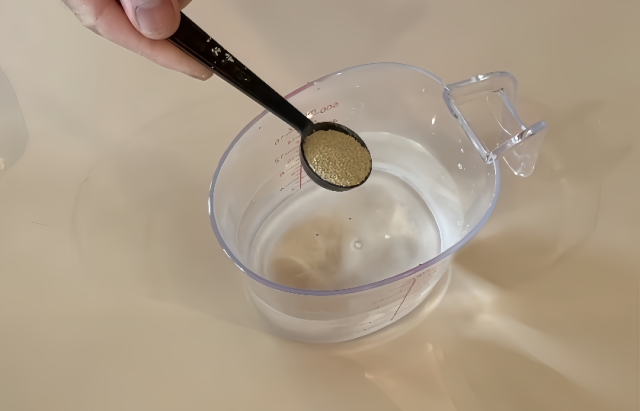Tasty Easy Pizza

It's time to put aside the complicated steps and join me in unlocking the secrets to making delicious and easy pizza! This recipe doesn't require complex techniques or expensive ingredients. You can easily make it at home and enjoy the wonderful taste of pizza anytime, anywhere. Whether you're a kitchen novice or a seasoned foodie, I guarantee you'll find it easy to make and enjoy that irresistible aroma straight from the oven!
Ingredients and Substitutes
To make this salami pizza, you'll need the following ingredients:
Main Ingredients
Flour: All-purpose flour is the primary ingredient for the pizza dough, providing the base texture and structure.
Salami Slices: Adds a distinctive flavor and protein to the pizza.
Cheese: Includes mozzarella and cheddar cheese, giving the pizza a rich, creamy taste and a stretchy texture.
Additional Ingredients
Tomatoes: Adds a sweet and tangy flavor along with a boost of vitamins.
Mushrooms: Enhances the texture and umami flavor.
Onions: Adds a fragrant aroma.
Pickled Peppers: Brings a bit of heat and unique flavor.
Seasonings
Sugar: Provides nutrients for yeast fermentation and adds a touch of sweetness.
Yeast: Causes the dough to rise.
Salt: Enhances flavor by adding a salty taste.
Olive Oil: Makes the dough softer and adds flavor.
Pizza Sauce: You can use canned pizza sauce or make your own with tomato sauce and spices.
Substitutes
All-Purpose Flour: You can partially substitute with bread flour or cake flour, but the texture will differ. Bread flour makes a chewier crust, while cake flour makes it softer.
Salami Slices: Can be replaced with ham, bacon, or other meats, though the flavor will change.
Mozzarella and Cheddar Cheese: Other cheeses like Parmesan can be used, but the stretchiness and flavor will differ.
Tomatoes: Can be substituted with tomato sauce, though fresh tomatoes provide better texture and nutrition.
Mushrooms: Can be replaced with shiitake or king oyster mushrooms, which will offer different textures and flavors.
Onions: Can be substituted with scallions or leeks, which have a similar aroma but stronger flavor.
Pickled Peppers: Can be replaced with hot sauce or chili powder, adjusting to personal heat preference.
Olive Oil: Can be substituted with corn oil, soybean oil, or other vegetable oils, though olive oil's unique flavor will be missed.
Pizza Sauce: If you don't have pizza sauce, you can make your own using tomato sauce, basil, oregano, and other spices, though it won't taste exactly the same as store-bought pizza sauce.
What Flour is Best for Pizza Dough
For making this pizza dough, all-purpose flour is the best choice.
All-purpose flour has a protein content of around 8%-11%, making it ideal for pizza dough. It provides enough elasticity to support the toppings without breaking, while also ensuring the dough is soft and not too hard.
When kneading, all-purpose flour forms a good gluten network, giving the dough elasticity and extensibility. This allows you to easily stretch it into thin sheets to cover the baking tray and create edges. The baked crust will be soft and chewy, perfectly complementing the toppings.
If you don't have all-purpose flour, you can mix bread flour and cake flour as a substitute. Bread flour has a higher protein content and stronger gluten, which can make the crust a bit harder. Mixing it with cake flour in a 7:3 or 8:2 ratio can achieve a texture similar to that of all-purpose flour.

How Long Should the Dough Ferment?
Typically, the first proofing lasts about 15 minutes. This initial rest helps the dough relax and become easier to handle.
The second proofing takes longer, requiring about two hours in a warm place until the dough doubles in size. This allows the dough to develop a rich, honeycomb-like structure inside, resulting in a soft and airy crust when baked.
However, keep in mind that fermentation time can be affected by the ambient temperature. If it's warm, the dough might ferment a bit faster; if it's cooler, it might take longer. The key is to ensure the dough has doubled in size, regardless of the exact timing.
Tips for Success
Dough Techniques:
Mixing Ingredients: Use 40°C (104°F) warm water to activate the yeast. Combine it with flour, salt, and olive oil, ensuring not to overmix.
Kneading and Proofing: Knead the dough until no dry flour remains and it comes together. Let it rest for 15 minutes, then knead until smooth. Allow it to proof in a warm place for two hours until it doubles in size.
Topping Techniques:
Proper Combination: Choose fresh ingredients and cut them evenly. Use a mix of mozzarella, cheddar, and Parmesan cheese.
Layering Order: Spread the pizza sauce evenly on the dough. Add salami slices first, then vegetables in order of their moisture content, and finally cover with a generous layer of cheese.
Baking Techniques:
Temperature and Time: Preheat the oven to 425°F. Bake the pizza for 15-20 minutes, rotating the baking sheet halfway through. The pizza is done when the crust is golden brown and the cheese is melted and bubbly with a slight golden hue.
INGREDIENTS
Main Ingredients
-
·600g all-purpose flour
-
·200g salami slices
-
·300g shredded mozzarella and cheddar cheese mix
Additional Ingredients
-
·2 tomatoes
-
·100g mushrooms
-
·1 onion
-
·2 pickled peppers
Seasonings
-
·1 teaspoon sugar
-
·1 teaspoon yeast
-
·3g salt
-
·20ml olive oil
-
·20g pizza sauce
COOKING STEP
Step 1
Mix 400ml of warm water (about 104°F) with 1 teaspoon of sugar and 1 teaspoon of yeast. Stir

Step 2
Combine 600g of all-purpose flour with salt, sugar, and 20ml of olive oil. Add the yeast mixture and knead into a dough. Let it rest for 15 minutes, then knead until smooth.

Step 3
Divide the dough into two portions, shape into balls, and place them in an oiled bowl. Cover with plastic wrap and let rise in a warm place.

Step 4
Finely chop tomatoes, mushrooms, and onions. Prepare pickled peppers.

Step 5
Preheat the oven to 425°F and grease a baking sheet.

Step 6
Once the dough has risen, transfer it to the baking sheet. Shape it into a thin crust with slightly raised edges, stretching it to fit the sheet.

Step 7
Brush the edges with remaining oil and spread pizza sauce over the crust.

Step 8
Layer with slices of salami and a small amount of Parmesan cheese.

Step 9
Sprinkle with vegetables that cook quickly, add a layer of thick cheese, then place tomatoes and pickled peppers on top, followed by more cheese.

Step 10
Bake in the oven for 15-20 minutes, rotating the baking sheet halfway through.

Recipe Variations
There are many fun variations you can try with a homemade salami pizza recipe.
Dough Variations:
You can add some herbs to the dough, such as rosemary or crushed basil leaves, to give the crust a unique flavor. Alternatively, you can replace part of the all-purpose flour with whole wheat flour to increase the dietary fiber content, making the crust healthier. The distinct aroma of whole wheat will also add a special touch to your pizza.
Topping Variations:
For the vegetables, in addition to mushrooms, onions, and tomatoes, you can try adding bell peppers, corn kernels, broccoli, and more for a colorful and varied texture. If you enjoy seafood, you can substitute the salami with shrimp, squid rings, or other seafood to make a seafood pizza. When it comes to cheese, you can experiment with unique flavors like blue cheese, but be mindful of the quantity as it has a strong taste.
Sauce Variations:
There are multiple options for sauces as well. Besides the traditional pizza sauce and tomato sauce, you can use a creamy white sauce for a rich, milky flavor. Or, you can make your own special sauce, such as an Italian tomato garlic sauce made with fresh tomatoes, garlic, olive oil, and herbs.
Serving Suggestions
Recommended Pairings:
Juices:Freshly squeezed orange juice, rich in vitamin C, offers a tangy and sweet flavor that feels like sunshine in your mouth. Paired with pizza, it creates a delightful symphony on your taste buds. Apple juice, with its gentle sweetness, adds a refreshing touch to the overall dining experience.
Classic Vegetable Salad:Combine fresh vegetables like lettuce, cucumber, tomatoes, and purple cabbage. Toss with olive oil, vinegar, and a pinch of salt for a simple yet refreshing salad. The crispness of the vegetables contrasts nicely with the hearty pizza, enriching the texture and balancing the meal.
Serving Tips:
For the best experience, try to enjoy the pizza shortly after it comes out of the oven. At this point, the temperature is optimal, the cheese is perfectly melted, and the crust is crispy on the outside and tender on the inside. This ensures that all the flavors are harmoniously blended, allowing you to savor the most authentic pizza taste.
If you're sharing the pizza with others, use a pizza cutter or wheel to slice it into convenient, bite-sized pieces, making it easier for everyone to enjoy.
FAQs:
Mozzarella: A classic choice for pizza, it’s soft, stretchy, and melts beautifully. It has a rich, mild flavor that complements other toppings without overpowering them.
Parmesan: Known for its rich, complex flavor with nutty and salty notes. Just a small amount, grated and sprinkled on top, can add depth to your pizza after baking.
Cheddar: Available in various maturities, it offers a robust flavor that pairs well with toppings, making the pizza taste richer.
Brie: Soft and creamy, with a luxurious, buttery taste that adds an elegant touch to your pizza.
Traditional salami pizza typically uses mozzarella as a base, with a sprinkle of Parmesan for extra flavor. You can also experiment with cheddar or brie for a unique twist.
As for time, it usually takes 15 - 20 minutes. However, this can vary based on the size of the pizza, the thickness of the crust, and the amount of toppings.
For smaller, thinner pizzas or those with fewer toppings, you might only need 12 - 15 minutes.
For larger pizzas with thick crusts or lots of toppings, it could take 20 - 25 minutes or even longer.
During baking, it’s a good idea to rotate the pizza halfway through to ensure even cooking and a beautifully browned crust.
Yeast and Fermentation: Increase the yeast by 1/4 from the original recipe. Activate it by mixing with warm water (about 104°F), a teaspoon of sugar, and the yeast. Let it sit for 5 minutes. Ensure ample fermentation time: let the dough rest for 15 minutes initially, then let it rise in a warm place for two hours until it doubles in size.
Dough Hydration: Add a bit more water while kneading until the dough is moist but not too soft or hard.
Additional Ingredients: For every 3 cups of flour, add 1-2 tablespoons of olive oil or butter. You can also substitute some water with milk for a softer texture and a hint of creaminess.
Freshly Ground Sea Salt: Adds a savory, slightly sweet taste reminiscent of the ocean, enhancing the natural flavors of the ingredients.
Freshly Ground Black Pepper: Enhances flavor, adds freshness, and reduces any gamey taste, especially good with beef toppings.
Extra Virgin Olive Oil: With low acidity, it's perfect for drizzling over pizza to add aroma and a smooth texture.
Balsamic Glaze: Made from grapes, it has a fruity aroma and mild acidity. Drizzle it on pizza for a touch of sweet and tangy flavor.

















